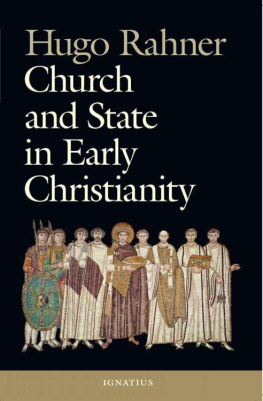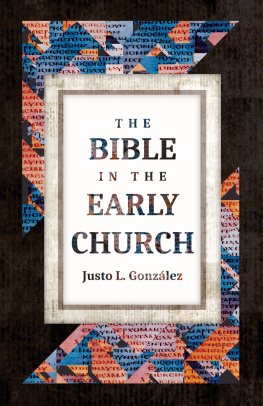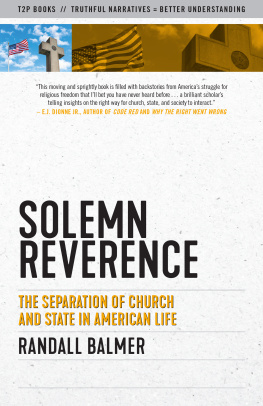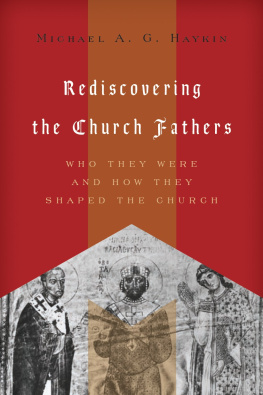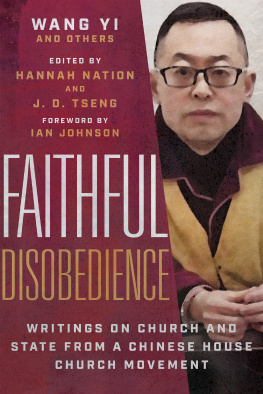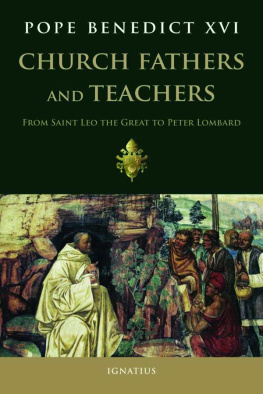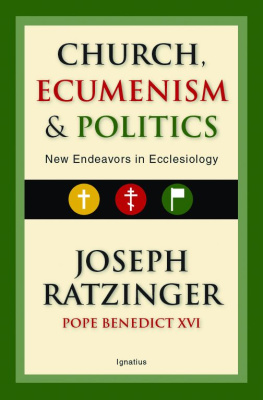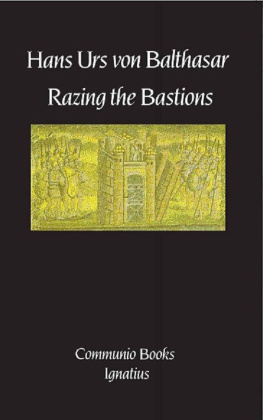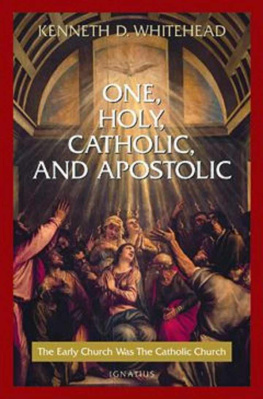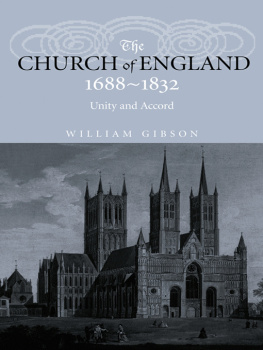CHURCH AND STATE
IN EARLY
CHRISTIANITY
HUGO RAHNER, S.J.
CHURCH AND STATE
IN EARLY
CHRISTIANITY
Translated by
Leo Donald Davis, S.J.
IGNATIUS PRESS SAN FRANCISCO
Title of the German original:
Kirche und Staat im frhen Christentum:
Dokumente aus acht Jahrhunderten und ihre Deutung
1961 Ksel Verlag, GmbH & Company, Munich
Cover art:
Court of Justinian
Early Christian mosaic, A.D. 500-525.
S. Vitale, Ravenna, Italy
Scala / Art Resource, New York
Cover design by Roxanne Mei Lum
1992 by Ignatius Press, San Francisco
Reprinted 2005, Ignatius Press, San Francisco
All rights reserved
ISBN 978-0-89870-377-1
ISBN 0-89870-377-8
Library of Congress Control Number 91-76752
Printed in the United States of America
Contents
I Church and State in the Age of the Martyrs
(Second and Third Centuries)
II The Struggle for the Churchs Freedom
under the Constantinian State
(Fourth Century)
III The Separation of Church and State
(Fifth Century)
IV The Struggle against Justinian
(Sixth Century)
V Rome and Constantinople to the
Age of Charlemagne
(Sixth to Eighth Centuries)
Abbreviations
A-NF Ante-Nicene Fathers (New York, 1901)
CSEL Corpus Scriptorum Ecclesiasticorum Latinorum (Vienna, 1866- )
GCS Graecorum Corpus Scriptorum (Berlin, 1897- )
MGH Monumenta Germaniae Historica , Auctores Antiquissimi, 13 vols. (Berlin, 1877-98)
Mansi Sacrorum Conciliorum Collectio Nova et Amplissima , ed. J. D. Mansi (Florence, 1759ff.)
NP-NF Nicene and Post-Nicene Fathers (New York, 1901)
PG J. P. Migne, Patrologiae Cursus Completus , series graeca, 161 vols. (Paris, 1857-66)
PL J. P. Migne, Patrologiae Cursus Completus , series latina, 217 vols. (Paris, 1844-64)
Thiel A. Thiel, Epistulae Romanorum Pontificium (Braunsberg, 1868)
TU Texte und Untersuchungen zur Geschichte der Altchristlichen Literature (Leipzig, 1882ff.)
Biblical quotations are taken from The New American Bible (New York, 1970).
Foreword
The name Rahner looms large in contemporary theology: Karl, as perhaps the most influential speculative Catholic theologian of his generation, and his older brother Hugo, equally important in the fields of Church history and patristics.
Father Hugo Rahner was born in 1900 at Pluffendorg-Baden. Entering the Society of Jesus in 1919, he completed his theological studies at the University of Innsbruck in Austria, and from 1931 to 1934 pursued doctoral studies in Church history in Bonn under J. Dlger. Professor of Church history and patristics at Innsbruck in 1937, he was forced the next year into exile in Switzerland until the end of the Second World War. In 1945 he returned to Innsbruck as dean of the theological faculty and then from 1949 to 1950 as rector of the university. Ill health forced his retirement from the classroom in 1962. He died in 1968.
He was the author of a prodigious number of books and articles, and the book here translated is a standard entry in all bibliographies dealing with the history of Church-state relations. Though reedited thirty years ago, the book still retains it usefulness, though perhaps, had he written it after the Declaration on Religious Liberty of the Second Vatican Council, he might have been somewhat more critical of the early Churchs attitude toward dissent and her appeals to the state to deal with it. For, in fact, as the Council itself recalled,... in the life of the people of God in its pilgrimage through the vicissitudes of human history there has at times been a form of behavior which was hardly in keeping with the spirit of the Gospel and was even opposed to it. which carries the story of the problem through the Middle Ages.
The translator offers this volume to an English-reading audience with the prayer of the Second Vatican Council: May God, the Father of all, grant that the human family by carefully observing the principles of religious liberty in society may be brought by the grace of Christ and the power of the Holy Spirit to that glorious freedom of the children of God (Rom 8:21) which is sublime and everlasting.
Leo Donald Davis, S.J.
Florence, Italy
Feast of St. Ambrose, 1991
Introduction
The first edition of this book appeared seventeen years ago when the struggle between Church and state in Nazi Germany was at its height. It then bore the title: The Liberty of the Western Church, Documents Concerning Church-State Relations in Early Christianity (Einsiedeln-Cologne: Benziger, 1943). Since then times have become more tranquil, but only in a superficial and impermanent way. Thus the question of the relations between Church and state remains as interesting as ever; it is a continuing problem in America and Russia and could at any moment reappear in Germany now that it has again become a world power. This alone would justify a new edition. The book remains substantially unchanged in form and fundamental ideas. It provides the living witness of the early Church to the solution of the ever-recurring problem touching us as citizens of a state and members of the Church because all persons, in addition to the complex of influences affecting their personality and status as citizens, are in the Church or are called to her. For the Church is the Kyriak, the queen just as Christ is the King. She must, therefore, proclaim to all generations and to all states the revelation that Christ the Redeemer has brought to mankind in his power and majesty. And the state is called to listen to the Church. But both those who make the proclamation and those who hear it must do so in a way that neither exceeds nor blurs the limits of the mutual autonomy that God the Creator has set for the state, and God the Redeemer for the Church. Because citizens of the state and the members of the Church are the same individuals, the problem of the just relationship between Church and state remains a difficult and vital question for all.
The history of this problem has been a turbulent one right down to our own times. Its solution has risen out of struggle and death ever since Christ in masterly fashion drew a distinction between God and emperor while at the same time decreeing obedience to both God and emperor
It seems then that from the beginning the relationship of Church to state consisted of a clash rising out of that necessary sin of Adam of which Augustine speaks, a necessary consequence of the fact that men, weighed down by original sin, fall into the prime sin of pride, a worship of their own creation as they build up a state. This can happen as well to the Church as she strives toward spiritual liberty and toward her supernatural goal yet is tempted in the course of her struggle to build a theocracy purely of this world. This is a necessary struggle, for only in the course of it do the combatants on either side, caught up in the unfolding of history, constantly tempted to excessive demands and enmeshed in the slow evolution of state and Church, come to recognize the limits which separate them, limits which are marked by a border not a wall. Their mutual relationship has its roots in the personal unity of the Creator and the Redeemer but it should not become confused resulting in the dominance of the state over the Church (caesaropapism) or of the Church over the state (papal theocracy).
The two-thousand-year history of the Church has revealed every facet of this relationship. From the days of the apostles to our own, the Church has been tried before kings and judges and has fought for freedom to pursue her other-worldly goals; but she has also run the risk of being king and judge over the people, from the period of late antiquity when Constantine called himself the apostles equal and bishop for external affairs; from the reign of Justinian, the priest-emperor and of his tyrannous successors on the Byzantine throne to whom the Eastern Church was subservient to the extent of surrendering her own rights; from the Middle Ages when the Church, victorious in the mortal combat against imperial power, for a while regarded herself as possessing the two keys of spiritual and temporal power as an exclusive and inalienable right.
Next page
